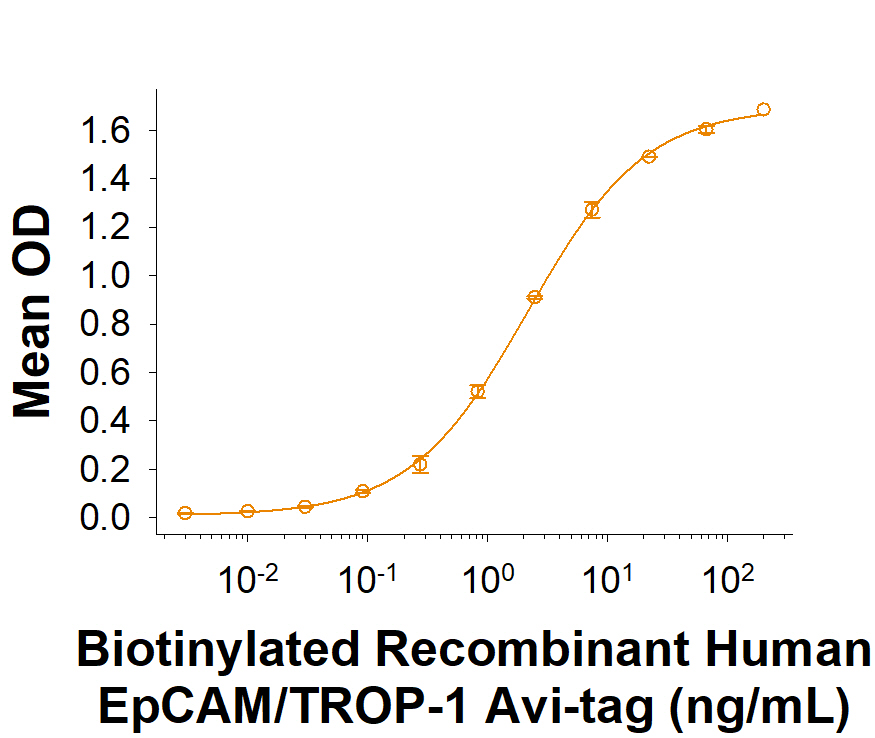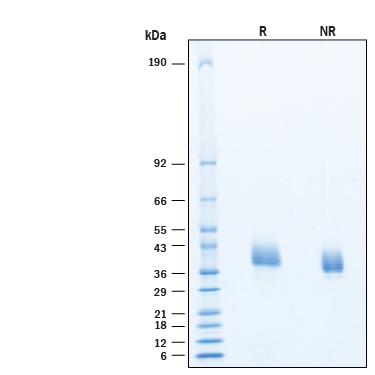Recombinant Human EpCAM/TROP1 Avi-tag His-tag Protein, CF
Recombinant Human EpCAM/TROP1 Avi-tag His-tag Protein, CF Summary
Product Specifications
| Human EpCAM (Gln24-Lys265) Accession # P16422.2 | Avi-tag | 6-His tag |
| N-terminus | C-terminus | |
Analysis
Product Datasheets
Carrier Free
CF stands for Carrier Free (CF). We typically add Bovine Serum Albumin (BSA) as a carrier protein to our recombinant proteins. Adding a carrier protein enhances protein stability, increases shelf-life, and allows the recombinant protein to be stored at a more dilute concentration. The carrier free version does not contain BSA.
In general, we advise purchasing the recombinant protein with BSA for use in cell or tissue culture, or as an ELISA standard. In contrast, the carrier free protein is recommended for applications, in which the presence of BSA could interfere.
AVI9277
| Formulation | Lyophilized from a 0.2 μm filtered solution in PBS with Trehalose. |
| Reconstitution | Reconstitute at 500 μg/mL in PBS. |
| Shipping | The product is shipped at ambient temperature. Upon receipt, store it immediately at the temperature recommended below. |
| Stability & Storage: | Use a manual defrost freezer and avoid repeated freeze-thaw cycles.
|
Scientific Data
 View Larger
View Larger
Measured by its binding ability in a functional ELISA. Biotinylated Recombinant Human EpCAM/TROP‑1 Avi-tag His-tag (Catalog # AVI9277) binds to Human EpCAM/TROP-1 Antibody (AF960) with a ED50 of 0.750-7.50 ng/mL.
 View Larger
View Larger
2 μg/lane of Biotinylated Recombinant Human EpCAM/TROP‑1 Avi-tag His-tag Protein (Catalog # AVI9277) was resolved with SDS-PAGE under reducing (R) and non-reducing (NR) conditions and visualized by Coomassie® Blue staining, showing bands at 35-42 kDa.
Reconstitution Calculator
Background: EpCAM/TROP1
Epithelial Cellular Adhesion Molecule (EpCAM), also known as KS1/4, gp40, GA733-2, 17-1A, and TROP‑1, is a 40 kDa transmembrane glycoprotein that consists of a 242 amino acid (aa) extracellular domain with two EGF‑like repeats, a 23 aa transmembrane segment, and a 26 aa cytoplasmic domain (1). Human and mouse EpCAM share 82% aa sequence identity. During embryonic development, EpCAM is detected in fetal lung, kidney, liver, pancreas, skin, and germ cells. In adults, human EpCAM is expressed on basolateral cell membranes of all simple, pseudo-stratified, and transitional epithelia but not on normal squamous stratified epithelia, mesenchymal tissue, muscular tissue, neuro-endocrine tissue, or lymphoid tissue (2). It is additionally expressed on undifferentiated embryonic stem cells, thymocytes, and dendritic cells (3-5). It is up-regulated on actively proliferating epithelial tissues, during adult liver regeneration, and on many epithelial cell-derived carcinomas (2, 6). EpCAM functions as a homophilic cell adhesion molecule (7). It associates into tetramers and forms complexes in cis with Claudin-7, CD44v6, TSPAN8, CD9, Integrin alpha 3, and Annexin A1 (8-11) that can interfere with cell adhesion (12, 13). Proteolytic cleavage of EpCAM releases multiple fragments from the ECD as well as a cytoplasmic fragment that can regulate gene transcription (14-16). Our Avi-tag Biotinylated Recombinant Human EpCAM features biotinylation at a single site contained within the Avi-tag, a unique 15 amino acid peptide. Protein orientation will be uniform when bound to streptavidin-coated surface due to the precise control of biotinylation and the rest of the protein is unchanged so there is no interference in the protein's bioactivity.
- Strnad, J. et al. (1989) Cancer Res. 49:314.
- Schnell, U. et al. (2013) Biochim. Biophys. Acta 1828:1989.
- Ng, V.Y. et al. (2010) Stem Cells 28:29.
- Nelson, A.J. et al. (1996) Eur. J. Immunol. 26:401.
- Borkowski, T.A. et al. (1996) Eur. J. Immunol. 26:110.
- de Boer, C.J. et al. (1999) J. Pathol. 188:201.
- Litvinov, S.V. et al. (1994) J. Cell Biol. 125:437.
- Balzar, M. et al. (2001) Mol. Cell. Biol. 21:2570.
- Nubel, T. et al. (2009) Mol. Cancer Res. 7:285.
- Kuhn, S. et al. (2007) Mol. Cancer Res. 5:553.
- Schmidt, D.S. et al. (2004) Exp. Cell Res. 297:329.
- Litvinov, S.V. et al. (1997) J. Cell Biol. 139:1337.
- Gaiser, M.R. et al. (2012) Proc. Natl. Acad. Sci. USA 109:E889.
- Schnell, U. et al. (2013) Biosci. Rep. 33:e00030.
- Schon, M.P. et al. (1993) Int. J. Cancer 55:988.
- Maetzel, D. et al. (2009) Nat. Cell Biol. 11:162.
FAQs
No product specific FAQs exist for this product, however you may
View all Proteins and Enzyme FAQsReviews for Recombinant Human EpCAM/TROP1 Avi-tag His-tag Protein, CF
There are currently no reviews for this product. Be the first to review Recombinant Human EpCAM/TROP1 Avi-tag His-tag Protein, CF and earn rewards!
Have you used Recombinant Human EpCAM/TROP1 Avi-tag His-tag Protein, CF?
Submit a review and receive an Amazon gift card.
$25/€18/£15/$25CAN/¥75 Yuan/¥1250 Yen for a review with an image
$10/€7/£6/$10 CAD/¥70 Yuan/¥1110 Yen for a review without an image


